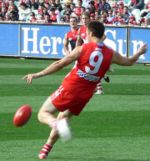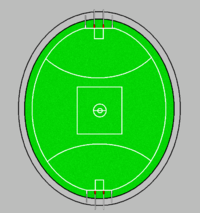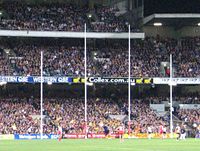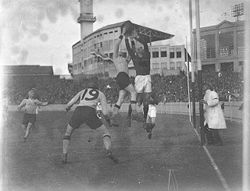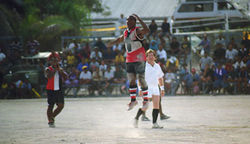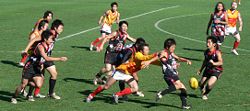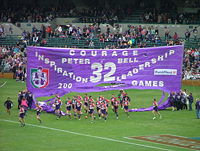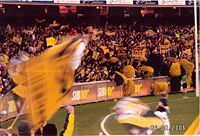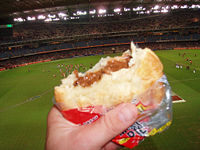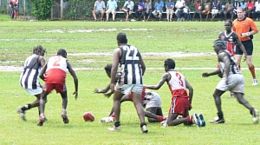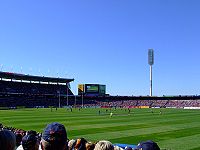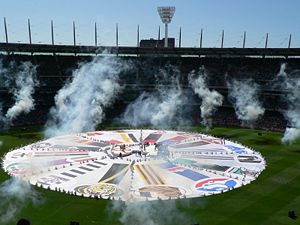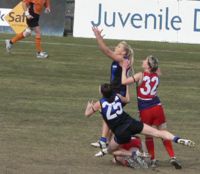Australian rules football
2008/9 Schools Wikipedia Selection. Related subjects: Sports
 High marking (catching the ball high in the air) is a key skill in Australian rules football |
|
| Highest governing body | Australian Football League |
|---|---|
| Nickname(s) | Australian Football (official name), Australian Rules, "Aussie" Rules, Football, Footy, AFL |
| First played | 1859, Melbourne |
| Registered players | 650,394 (total) 130,000 (adult) (2007) |
| Clubs | 2,650 |
| Characteristics | |
| Contact | Contact |
| Team members | 22 |
| Mixed gender | Single |
| Category | Outdoor |
| Ball | Football (ball) |
Australian rules football, Australian football, Aussie rules, or simply "football" or "footy" is a team sport played between two teams of 18 players with a ball in the shape of a prolate spheroid. It is a football variant played outdoors on large oval shaped grass fields (often also used as a cricket ground), with four goal posts at each end.
The primary aim of the game is to score goals by kicking the ball between the middle two posts of the opposing goal. The winner is the team who has the higher total score at the end of the fourth quarter. Except for special circumstances, if the score is tied then a draw is declared.
Players may use any part of their body to advance the ball. The primary methods are kicking, handballing and running with the ball. There are restrictions on how the ball can be handled, for example players running with the ball must intermittently bounce or touch it on the ground, throwing the ball is not allowed and players must not get caught holding the ball. Unlike most similar sports, there is no offside rule and players can roam the field freely. Possession of the ball is in dispute at all times except when a free kick is paid. A distinctive feature of the game is the mark, where players anywhere on the field who catch a ball from a kick (with specific conditions), are awarded a free kick. Australian rules is a contact sport in which players can tackle using their hands or use their whole body to obstruct opponents. Dangerous physical contact (such as a pushing an opponent in the back), interference when marking and deliberately slowing the play are discouraged with free kicks, distance penalties or suspension, depending on the seriousness of the infringement. Frequent physical contests, aerial marking or " speckies", fast movement of both players and the ball and high scoring are the game's main attributes as a spectator sport.
Details of the game's origins in Australia are obscure and still the subject of much debate. Accounts of various forms of "foot-ball" being played in the Victorian goldfields that shared similar attributes to Australian football date back to 1853. Australian football became organised in Melbourne in 1858 with a series of experimental rules in a bid to keep cricketers fit during the winter months and in 1859 the first laws of the game were published by the Melbourne Football Club.
Today Australian rules football is played extensively in Australia with competitions in all Australian states and two territories. It is also played at amateur level in several countries and in several variations but only played professionally in Australia. The most prestigious and only national competition in Australia is the Australian Football League (AFL), which culminates in the annual AFL Grand Final, the highest attended club championship event in the world. The league has governed the sport through the AFL Commission and the AFL Rules Committee, since it disbanded the Australian National Football Council in 1993 and International Australian Football Council in 2002.
In 2008, the 150th anniversary of the first recorded games of Australian football is being celebrated around the country. Organised events include the publishing of an official history in a book titled The Australian Game of Football , the AFL Hall of Fame Tribute Match, events at many community based football clubs, the 2008 Australian Football International Cup and the return of the International Rules Series with the 2008 International Rules Series.
Structure and competitions
The football season, proper, is from March to August (early autumn to late winter in Australia) with finals being held in September. In the tropics, the game is sometimes played in the wet season (October to March). Pre-season competitions in southern Australia usually begin in late February.
The AFL is recognized by the Australian Sports Commission as being the National Sporting Organisation for Australian rules football. There are also seven state/territory-based organisations in Australia, most of which are now either owned by or affiliated to the AFL.
Most of these hold annual semi-professional club competitions while the others oversee more than one league. Local semi-professional or amateur organizations and competitions are often affiliated to their state organisations.
The AFL is also the de facto world governing body for Australian rules football. There are also a number of affiliated organisations governing amateur clubs and competitions around the world.
For almost all Australian rules competitions the aim is to win the Premiership. The premiership is always decided by a finals series. The teams that occupy the highest positions on the ladder play off in a "semi-knockout" finals series. From the 1930s the finals series was usually contested by the top 4 teams (3rd versus 4th (First semifinal); 1st versus 2nd (Second semifinal); winner of First versus loser of Second (Preliminary final); the winner of Second versus winner of Preliminary playing in the Grand Final for the premiership). Many leagues have adopted a final series involving 5, 6 or 8 teams with a variety of methods used to determine the winner. The AFL finals system is contested by the top 8 teams.
Unlike most soccer competitions there are usually no separate "league" and "cup" trophies. The team finishing first on the ladder is often referred to as a 'minor premier', although this bears little or no significance. In the AFL, this is the McClelland Trophy. and is considered a consolation prize. The team which finishes at the bottom of the ladder at the end of the season is said to receive 'the wooden spoon'
Rules of the game
Both the ball and the field of play are oval in shape. No more than 18 players of each team are permitted to be on the field at any time.
Up to four interchange (reserve) players may be swapped for those on the field at any time during the game. In Australian rules terminology, these players wait for substitution "on the bench" - an area with a row of seats on the sideline.
There is no offside rule nor are there set positions in the rules; unlike many other forms of football, players from both teams disperse across the whole field before the start of play. However, only four players from each team are allowed within the 50 m centre square before every centre bounce, which occurs at the commencement of each quarter, and to restart the game after a goal is scored. There are also other rules pertaining to allowed player positions during set plays (i.e., after a mark or free kick) and during kick-ins following the scoring of a behind.
A game consists of four quarters. The length of the quarters can vary from 15 to 25 minutes in different leagues. In the AFL, quarters are 20 minutes, but the clock is stopped when the ball is out of play, meaning that an average quarter could last for 27 to 31 minutes. At the end of each quarter, teams change their scoring end.
Games are officiated by umpires. Australian football begins the game similarly to basketball. After the first siren, the umpire bounces the ball on the ground (or throws it into the air if the condition of the ground is poor), and the two ruckmen (typically the tallest players from each team), battle for the ball in the air on its way back down.
The ball can be propelled in any direction by way of a foot, clenched fist (called a handball or handpass) or open-hand tap (unlike rugby football there is no knock-on rule) but it cannot be thrown under any circumstances. Throwing is defined in the rules quite broadly but is essentially any open hand disposal that causes the ball to move upward in the air.
A player may run with the ball but it must be bounced or touched on the ground at least once every 15 metres. Opposition players may bump or tackle the player to obtain the ball and, when tackled, the player must dispose of the ball cleanly or risk being penalised for holding the ball. The ball carrier may only be tackled between the shoulders and knees. If the opposition player forcefully contacts a player in the back whilst performing a tackle, the opposition player will be penalised for a push in the back. If the opposition tackles the player with possession below the knees, it is ruled as a low tackle or a trip, and the team with possession of the football gets a free kick.
If a player takes possession of the ball that has travelled more than 15 metres from another player's kick, by way of a catch, it is claimed as a mark and that player may then have a free kick (meaning that the game stops while he prepares to kick from the point at which he marked). Alternatively, he may choose to "play on:" forfeiting the set shot in the hope of pressing an advantage for his team (rather than allowing the opposition to reposition while he prepares for the free kick). Once a player has chosen to play on, normal play resumes and the player who took the mark is again able to be tackled.
There are different styles of kicking depending on how the ball is held in the hand. The most common style of kicking seen in today's game, principally because of its superior accuracy, is the drop punt (the ball is dropped from the hands down, almost to the ground, to be kicked so that the ball rotates in a reverse end over end motion as it travels through the air). Other commonly used kicks are the torpedo punt (also known as the spiral or screw punt; the ball is held at an angle and kicked, which makes the ball spiral in the air, resulting in extra distance) and the checkside punt or "snap", used to curve the ball towards targets that are on an angle. Forms of kicking which have now disappeared from the game include the drop kick (similar to the drop punt except that the ball is allowed to make contact with the ground momentarily before being struck with the foot) and place kick (where the ball is first placed on the ground when shooting for goal, similar to the place kick used in rugby union).
Apart from free kicks or when the ball is in the possession of an umpire for a ball up or throw in, the ball is always in dispute and any player from either side can take possession of the ball.
A goal is scored when the football is propelled through the goal posts at any height (including above the height of the posts) by way of a kick from the attacking team. It may fly through on the full or bounce through, but must not have been touched, on the way, by any player from either team. A goal cannot be scored from the foot of an opposition (defending) player.
A behind is scored when the ball passes between a goal post and a behind post at any height, or if the ball hits a goal post, or if an attacking player sends the ball between the goal posts by touching it with any part of the body other than a foot. A behind is also awarded to the attacking team if the ball touches any part of an opposition player, including his foot, before passing between the goal posts. When an opposition player deliberately scores a behind for the attacking team (generally as a last resort, because of the risk of their scoring a goal) this is termed a rushed behind.
If the ball hits one of the behind posts, the ball is considered out of bounds and no score is awarded.
A goal is worth 6 points whereas a behind is worth 1 point. The Goal Umpire signals a goal with two hands raised at elbow height, a behind with one hand, and then confirms the signal with the other goal umpire by waving flags above his head.
The team that has scored the most points at the end of play wins the game. If the scores are level on points at the end of play, then the game is a draw; extra time applies only during finals matches in some competitions.
As an example of a score report, consider a match between North Melbourne Football Club and the Sydney Swans. North Melbourne's score of 15 goals and 11 behinds equates to 101 points. Sydney's score of eight goals and ten behinds equates to a 58 point tally. North Melbourne wins the match by a margin of 43 points. Such a result would be written as:
- North Melbourne Football Club 15.11 (101) defeated Sydney Swans 8.10 (58);
and said,
- "North Melbourne fifteen eleven, one hundred and one defeated Sydney Swans eight ten, fifty-eight."
History
Origins of the Game
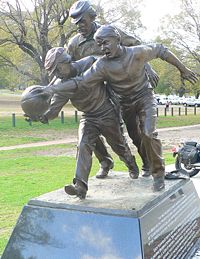
There is evidence of several unique forms of "foot-ball" being played in the Victorian Gold Fields which may have shared a range of influences. The Geelong rules began to take shape around 1856, although they were never codified. The Melbourne rules were formed through a series of experimental matches and eventually became dominant.
A letter by Tom Wills was published in Bell's Life in Victoria & Sporting Chronicle on 10 July 1858, called for a "foot-ball club" with a "code of laws" to keep cricketers fit during winter. This is widely regarded as the most significant milestone in the organisation of Australian football. It was during 1858 that references to the first "foot-ball" clubs in Melbourne began to appear, including Richmond Cricketers, St Kilda and Melbourne. His letter attracted football players to an experimental match, at the Richmond Paddock (later known as Yarra Park next to the MCG) on 31 July 1858. Few details of the match have survived, though it is known that Wills both played in and umpired the game.
The early connection with cricketers may be responsible for the shape and size of he field of play (a large oval, essentially a cricket ground - in fact many "sports ovals" in Australia double as cricket/football grounds) rather than the rectangular "pitch" more usual in other types of football; and even for the fact that the custodians of the game are designated as "umpires" (as in cricket) rather than "referees" (as in other football codes).
On 7 August 1858 a famous match between Melbourne Grammar School and Scotch College began at Richmond Park, which was umpired by Wills and McAdam and also involved Scotch headmaster Thomas H. Smith. A second day of play took place on 21 August and a third, and final, day on 4 September. While the full rules that were used is unknown, the match was played with a round ball, the distance between the goals was approximately half a mile (approximately 4 times longer than the modern MCG playing surface), there were 40 players per side and one goal each side was scored with the game being declared a draw. The two schools have competed annually ever since for the Cordner-Eggleston Cup.
Some regard these early matches as the first matches of Australian Football, however to many it is clear that the game was still in the process of evolving.
The First Rules
The Melbourne Football Club rules of 1859 are the oldest surviving set of laws for Australian football. They were drawn up at the Parade Hotel, East Melbourne, on 17 May and signed by Tom Wills, William Hammersley, J. Sewell, J. B. Thompson, Alex Bruce, T. Butterworth and Thomas H. Smith. The meeting was chaired by Wills and in attendance were journalists W. J. Hammersley and J. B. Thompson. Accounts of the people directly involved differ. Some sources also claim that H. C. A. Harrison and Thomas H. Smith were also present. Eleven simple Melbourne Football Club Rules were laid out, printed and, most significantly, widely publicised.
The influence of English public school and university football codes, while undetermined, was clearly substantial. All members of the committee had experience of English games. It is claimed that Tom Wills, himself an exceptional rugby player, wanted to introduce Rugby School rules but the other men felt Rugby School’s rough play and offside rules would not suit players older than schoolboys or the drier Australian conditions. The club did look at the Rugby School Rules but also those of Eton ( Eton field game), Winchester ( Winchester College football) and Harrow ( Harrow football). What is clear is Wills intentions, when during this meeting he made the now famous declaration "No, we shall have a game of our own".
Some historians, particularly Martin Flanagan postulate that Wills could have been inspired by marngrook, ball games played by the Aboriginal people in western Victoria. Wills was raised in Victoria's western districts and is said to have been fluent in the local dialect and frequently played with local Aboriginal children on his father's property, Lexington, in outside of the town of Moyston. Others dismiss this as an unsubstantiated romantic notion.
While it is clear even to casual observers that modern Australian rules football is similar to Gaelic football, the exact relationship between the two codes is a matter of controversy among historians. Although gaelic football was not codified until 1887, some claim that Irish games ( caid and hurling) were played in Australia as early as 1843. Historian B. W. O'Dwyer suggests that some of these elements of Australian rules may be attributed to the common influence of older Irish games as the rulemakers would have been familiar with these games.
Early Competition in Victoria
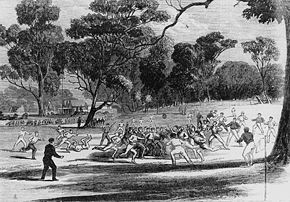
The Champion of the Colony (precursor to the Brownlow Medal) is an individual football award which was first granted in 1858.
Notably in 1859 several new football clubs formed including the Castlemaine Football Club, Geelong Football Club (which Wills directly helped to form) and the Melbourne University Football Club. While many one-off matches are recorded to have taken place between several early teams from Melbourne's suburbs and country Victoria (such as the Ballarat and Geelong competitions), in the early days many had not yet formed clubs for regular competition.
The first ever trophy for Australian Football, awarded by the Royal Caledonian Society of Melbourne and played under the Melbourne Rules was contested in 1861 between the Melbourne Football Club and Melbourne University, and was won by University. The competition continued into the early 1860s with the addition of other teams from Melbourne's suburbs. Two further competitions, the South Yarra Challenge Cup and "Second Twenties" were held between the late 1860s.
There were some rival rules which eventually gave way to an acceptance of the Melbourne Rules, the most notable being the Geelong rules. The requirement to bounce the ball while running was introduced in a redraft of the Melbourne Rules in 1866 by H. C. A. Harrison and his rules committee to satisfy the Geelong Football Club. Behind posts were introduced at this time are also believed to have come directly from the Geelong rules. The new rules became known as the Victorian Rules.
Spread of the game in Australia and New Zealand
Gradually the game – known at first as "Melbourne Rules" became "Victorian Rules" and then "Australian Rules" following its spread from Victoria into other Australian colonies, beginning with South Australia ( 1860), Tasmania (1864), Queensland (1866) and New Zealand (1876). In 1877, the sport's first governing bodies, the South Australian Football Association and the Victorian Football Association were formed on the 30th of April and the 7th of May respectively. The game began to be played in New South Wales in 1877, in Western Australia in 1881 and the Australian Capital Territory in 1911. By 1916, the game was first played in the Northern Territory, establishing a permanent presence in all Australian states and mainland territories.
The precursors of the South Australian National Football League (SANFL) and the West Australian Football League (WAFL) were strong, separate competitions by the 1890s. However, factors such as interstate rivalries and the denial of access to grounds in Sydney caused the code to struggle in New South Wales and Queensland. A rift in the VFA led to the formation of the Victorian Football League (VFL), which commenced play in 1897 as an eight-team breakaway of the stronger clubs in the VFA competition. By 1925, the VFL consisted of 12 teams, and had become the most prominent league in the game.
The first intercolonial match had been played between Victoria and South Australia in 1879. In 1908, a Jubilee Australasian Football Carnival was held to celebrate 50 years of football. The carnival included teams from Victoria, South Australia, Queensland, New South Wales, Tasmania and New Zealand. For most of the 20th century, the absence of a national club competition—and the inability of players to compete internationally—meant that matches between state representative teams were regarded with great importance. Because VFL clubs increasingly recruited the best players in other states, Victoria dominated these games. State of origin rules were introduced in 1977, and saw Western Australia and South Australia begin to win many of their games against Victoria.
The Effects of World War
Both World War I and World War II had a devastating effect on the sport of Australian Rules. While scratch matches were played by Australian "diggers" in remote locations around the world, the game lost many of its great players to wartime service. Some competitions never fully recovered. World War I saw the game in New Zealand go into recess for three quarters of a century. In Queensland, the state league went into recess for the duration of the war. VFL club University left the league and went into recess due to severe casualties and the WAFL also lost two clubs. The ANZAC Day clash is one example of how the war continues to be remembered in the football community.
A National Competition Emerges
By 1980 in the space of just 25 years, the way the game was played had changed dramatically, with the phasing out of many of the game's kicking styles, changing rules and the influence of the handballing game and television.
In 1982, in a move which heralded big changes within the sport, one of the original VFL clubs, South Melbourne, relocated to the rugby league stronghold of Sydney and became known as the Sydney Swans. In the late 1980s, strong interstate interest in the VFL led to a more national competition; two more non-Victorian clubs, the West Coast Eagles and the Brisbane Bears began playing in 1987. The league changed its name to the Australian Football League (AFL) following the 1989 season. In 1991, it gained its first South Australian team, Adelaide. During the next five years, two more non-Victorian teams, Fremantle and Port Adelaide, joined the league. The AFL, currently with 16 member clubs, is the sport's elite competition and the most powerful body in the world of Australian rules football and continues to seek further opportunities to expand into new markets.
Following the emergence of the Australian Football League, the SANFL, WAFL and other state leagues rapidly declined to a secondary status. Apart from these there are many semi-professional and amateur leagues around Australia, where they play a very important role in the community, and particularly so in rural areas. The VFA, still in existence a century after the original schism, merged with the former VFL reserves competition in 1998. The new entity adopted the VFL name and remained a primarily state based competition. State of origin games declined in importance, especially after an increasing number of withdrawals by AFL players, and Australian football State of Origin matches ceased in 1999. The second-tier state and territorial leagues still contest interstate matches.
Australian football internationally
Aussie Rules is played at an amateur level in countries around the world. At least 20 leagues that are recognised by the game's governing body, exist outside of Australia. Although semi-professional players have come from outside of Australia, and there have been several players in the VFL/AFL who were born outside Australia, no player to learn the game overseas has yet played a game in the Australian Football League.
The growth of Australian rules internationally went into rapid decline following World War I. After World War II, the sport experienced a small amount of growth in the Pacific region, particularly in Nauru, Papua New Guinea and later New Zealand.
Australian rules football is emerging as an international sport much later than other forms of football such as soccer or the rugby codes, but has grown substantially as an amateur sport in some countries since the 1980s. Initially the sport has grown with the Australian diaspora, aided by multiculturalism and assisted by exhibition matches and players who have converted to and from other football codes. In Papua New Guinea, New Zealand, South Africa and the United States there are many thousands of players. Great Britain, Canada, Japan, Denmark and Sweden have also shown strong potential in the sport amongst local players in the lead up to the 2008 Australian Football International Cup.
The AFL became the defacto governing body when it pushed for the closure of the International Australian Football Council in 2002.
Australian rules football is played professionally only by men in Australia and is major spectator sport only in Australia and Nauru with the exception of occasional exhibition games staged in other countries and carnival type events overseas.
International Rules Football
Since 1967 there have been many matches between Australian rules football teams (mainly from Australia) and Gaelic football teams (mainly from Ireland), under various sets of hybrid, compromise rules known as International rules football. In 1984, the first official representative matches of International Rules were played, and these were played annually each October between the AFL and the Gaelic Athletic Association between 1998 and 2006 as part of the official International Rules Series which attracted large crowds and media interest in both Ireland and Australia, however the series was cancelled in 2006 due to escalating violence between the two sides.
Traditions of the game
Australian Rules is a sport rich in tradition and Australian cultural references, especially surrounding the rituals of gameday for players, officials and supporters.
As part of their uniform, players wear shirts called guernseys. Guernseys are similar to basketball shirts, but of a more robust design, often referred to in Australia as "jumpers". In the early period of the game's development players often wore sleeveless lace-up tops which gradually disappeared between the 1960s and early 1980s. A few players choose to wear a long sleeved variation of the modern guernsey design. Players wore full length pants, before adopting shorts in the 1920s. Tight-fitting shorts were a notable fashion trend in most leagues in the 1980s and some players began to wear hamstring warmers. A brief experiment with lycra by the AFL in the State of Origin series was quickly abandoned for more traditional wear. Long socks (football socks) are compulsory and boots with moulded cleats or studs for gripping the ground are worn (screw-ins have been banned from most leagues since the 1990s).
Traditionally, umpires have worn white and were sometimes referred to as "white maggots" amongst supporters. AFL umpires now wear bright colours to also avoid clashes with the player guernseys and AFL goal umpires now wear t-shirts and caps, rather than the traditional white coat and broad brimmed hat (similar to what was worn by many cricket umpires) which they wore before the 1990s.
Typical supporter wear includes the team scarf and sometimes beanie (particularly in cooler climates) in the colours of the team. Team guernseys are also worn by supporters. Team flags are sometimes flown by supporters at the start of a game, when a goal is scored, and when their team wins.
Before AFL matches, it is traditional for teams to run through a crepe banner constructed by the cheersquads of each team. These often feature messages and slogans for the team in the context of the match, such as congratulating a player on a landmark number of games and more recently also sponsorship messages. The banners and sometimes also streamers are used in important local football matches such as finals. As players run through the banners, the team's song (or fight song) is sometimes also played or sung. The fight song is also sung by the winning team.
Australian rules supporters don't use the word 'root' for support (the word 'root' is Australian slang for 'sex'), but instead "barrack" for their team. Though other cultures have had an influence at various points in its history, Australian football tends to have different atmosphere to sports like soccer and American Football. Partly due to Australian culture, Australian rules spectators are generally more solitary animals. With the exception of small official cheersquads, spectators at Aussie Rules matches will rarely engage in support for their teams with organised chants. Instead, each individual spectator will most often shout their own support using the nickname of their team ie. "Carn the Crows !" or "Carn the Maggies". In contrast, cheersquads are highly organised, have their own rituals and almost always congregate behind the goals during games. Most professional clubs have official cheersquads which will sometimes wave enormous coloured pompoms known as floggers after the umpire has signalled a goal. American style cheerleading is very rare.
Meat pies and beer are popular consumables (sometimes noted as a tradition) for supporters at Australian rules matches. At AFL matches mobile vendors walk around the ground selling such pies, yelling out the well-known call of "hot pies, cold drinks!"
At the end of the match, it is traditional for a pitch invasion to occur. Supporters run onto the field to celebrate the game and play games of kick-to-kick with their families. In many suburban and country games, this also happens during quarter and half-time breaks. In the AFL in recent years, this tradition has been more strictly controlled with security guards to ensure that players and officials can safely leave the ground. At the largest AFL grounds, this tradition has been banned completely, to protect the surface, much to the discontent of fans. But smaller grounds ( Skilled Stadium, for example) still allow fans onto the field after the game. Sometimes a mid-game pitch invasion is expected for various highly anticipated landmark achievements (such as a player kicking a record number of goals).
Popularity
Australian rules football has attracted more overall interest among Australians (as measured by the Sweeney Sports report) than any other football code, and, when compared with all sports throughout the nation, has consistently ranked first in the winter reports, and most recently third behind cricket and swimming in summer. In some of the southern states, it is the most popular sport of all sports. As a football code, it is the most popular form of football in the Northern Territory, South Australia, Tasmania, Victoria and Western Australia. It is less popular in New South Wales and Queensland, although there has traditionally been strong support for the code in regions within those states, such as parts of southern New South Wales including the Riverina and parts of Queensland such as Cairns and the Gold Coast. The AFL teams from Brisbane and Sydney have attracted a strong increase in crowds, television audiences participation when they both recently won premierships. Demographic and migration trends have affected all football codes in recent years, but most significantly Australian football in Queensland, where Australian football has greatly increased in popularity over the past decade.
It is particularly popular amongst indigenous Australian communities. Indigenous Australians are well represented in professional AFL players: while only 2.4% of the population is of indigenous origin, 10% of AFL players identify themselves this way. Although it is a popular winter code cricket and swimming still eclipse it during the summer.
Australian rules is the national sport of Nauru.
Attendance
Australian rules football is the most highly attended spectator sport in Australia: government figures show that more than 2.5 million people attended games in 2005-06. In 2007 (including finals matches), a cumulative 7,049,945 people attended Australian Football League premiership matches, a record for the competition. In 2005, a further 307,181 attended NAB Cup pre-season matches and 117,552 attended Regional Challenge pre-season practice matches around the country.
As of 2005 the AFL is one of only five professional sports leagues in the world with an average attendance above thirty thousand (the others are the NFL in the United States and Major League Baseball in the U.S. and Canada, and the top division soccer leagues in Germany and England). In 2007, the average attendance of 38,113 made the AFL the second best attended domestic club league in the world, after only the NFL in the United States.
The Melbourne Cricket Ground is the largest stadium used for Australian rules football and the permanent home of the AFL Grand Final. It is one of the largest sporting stadiums in the world and was the venue for the record Australian rules football attendance of 121,696 at the 1970 VFL Grand Final, between Carlton and Collingwood - which game was also historic, in that it heralded the dawning of a new style of football - still largely in use today, wherein handballing was introduced more to commence the attack from the back line. Redevelopment since then to a mainly seated stadium has reduced the current capacity to approximately 100,000.
In addition to the national AFL competition, some semi-professional local leagues also draw significant crowds. Although crowds for state leagues have suffered in recent years, they continue to draw support, particularly for finals matches. The South Australian SANFL drew an attendance of 309,874 in 2006 and the Western Australian WAFL drew an official attendance of 207,154. Other leagues, such as the Victorian VFL (including a Tasmanian side, the Devils), Northern Territory Football League and the popular country league Ovens & Murray also charge admission and draw notable crowds (but with no available attendance figures).
Outside of Australia, the game has drawn notable attendances only for occasional carnival type events, such as International tests and exhibition matches.
Television
The national AFL is the main league which is shown on television in Australia and around the world.
The 2005 AFL Grand Final was watched by a record television audience of more than 3.3 million people across Australia's five most populous cities—the five mainland state capitals—including 1.2 million in Melbourne and 991,000 in Sydney. In 2006, the national audience was 3.145 million, including 1.182 million in Melbourne and 759,000 in Sydney.
According to OzTAM, in recent years, the AFL Grand Final has reached the top five programs across the five biggest cities in 2002, 2003, 2004, 2005 and 2006. In 2007, it was #1 in metropolitan markets. Australian rules football has achieved a #1 rating in the sports category in both 2004 and 2005.
Some of the more popular regional leagues in Australia have the "match of the week" televised locally and free-to-air on ABC Television's respective state networks. The SANFL is the most popular of these regional competitions measuring a total of 1,415,000 television viewers in 2007.
Some of these regional leagues also attracted a national audience through free-to-air broadcasting on television networks such as ABC2. OzTAM began measuring these audiences in 2006. Despite a large number of complaints, ABC2 withdrew all of these broadcasts in early 2008.
Australian rules also has a nominal but growing international audience. Since 2005, some AFL matches have been shown in the pacific rim region for the first time through the Australia Network. The AFL Grand Final is broadcast to many countries and attracts many million viewers worldwide. This audience has grown to approximately 30 million viewers from 72 countries.
According to Roy Morgan Research, more Americans watch Australian Rules Football than Australians. A poll taken between April 2002 and March 2004 showed that 7,496,000 North Americans compared to 7,004,000 Australians watch Australian Rules Football at least occasionally on television.
Participation
In 2006, a total of 615,549 registered participants played Australian football in Australia. Participation 7.84% between 2005-06. The Australian Sports Commission statistics show a 42% increase in the total number of participants over the 4 year period between 2001-2005.
Australian rules football is played in more than 30 countries around the world. In 2004, there were a total of over 25,000 participants outside of Australia. This has grown to about 35,000 people in 32 countries playing in structured competitions outside of Australia
Many related games have emerged from football, mainly with variations of contact to encourage greater participation. These include Kick-to-kick (and its variants such as 'Markers Up'), Auskick, Rec Footy, Women's Australian rules football, 9-a-side Footy, Masters Australian Football, handball and longest-kick competitions. Players outside of Australia sometimes engage in related games on the fields available, like Metro Footy (played on gridiron fields) and Samoa Rules (played on rugby fields).
Injuries and Prevention
Australian rules football is known for its high level of physical body contact compared to other sports such as soccer and basketball. High impact collisions can occur from any direction. Unlike gridiron, padding is not mandatory and is rarely worn. Combined with the range of activity including jumping, running and kicking, injury rates are relatively high.
Some ruckmen wear shin pads and thigh pads and players with head injuries sometimes wear soft helmets. Mouthguards are worn by most players but are only compulsory in some leagues.
Soft tissue injuries are the most frequent, including injuries to the thighs, hamstring and calf muscles. Osteitis pubis is a condition which particularly effects Australian rules footballers. Injuries to the knee, ankle and shoulders are also common. Hospital treated injuries, particularly for broken bones, account for 40 percent of all Australian rules football injuries.
Knee reconstructions are among the most commonly incurred career threatening injuries for both professional and amateur players, although professional players frequently continue to play after rehabilitation. Recently some players have undergone an inovative surgery that inserts a synthetic ligament in the knee which reduces the time out of football from twelve to three months.
Players can suffer head injuries, however spinal injuries are extremely uncommon and comparatively much lower than rugby football.
In cases of injury, players are able to be treated whilst on the ground and umpires generally only stop the play when players are removed from the ground on a stretcher. Most leagues have implemented a blood rule which forces players with bleeding wounds to leave the field for treatment until the bleeding is stopped.
In a study conducted recently of retired VFL/AFL footballers found that the most common problems amongst the group in old age included arthritis, hip replacements and low ability to perform sport-based activities.
In recent years the AFL has commissioned official studies as well as introduced new rules and precautions aimed at reducing the number and severity of injuries in the sport.
Australian rules in popular culture
For many years, the game of Australian rules football captured the imagination of Australian film, music, television and literature.
The Club, a critically acclaimed 1977 play by David Williamson, deals with the internal politics of a Melbourne football club steeped in tradition. The play was adapted as a film, directed by Bruce Beresford and starring Jack Thompson and Graham Kennedy, in 1980.
Many songs inspired by the game have become popular, none more so than the 1979 hit " Up There Cazaly", by Mike Brady. Brady followed the hit up with " One Day in September" in 1987. Both are frequently used in Grand Final celebrations.
Australian Football Hall of Fame
For the centenary of the VFL/AFL in 1996, the Australian Football Hall of Fame was established. In that year 136 identities were inducted, including 100 players, 10 coaches, 10 umpires, 10 administrators and six media representatives.
The selections have caused some controversy, mainly because of the predominance of VFL players at the expense of those who played in other leagues in the years before there was a national competition.
The elite Legend status was bestowed on 12 members of the Hall of Fame in 1996: Ron Barassi, Haydn Bunton Senior, Roy Cazaly, John Coleman, Jack Dyer, Polly Farmer, Leigh Matthews, John Nicholls, Bob Pratt, Dick Reynolds, Bob Skilton and Ted Whitten (see above list for further details).
The following ten members have been promoted to the status of "Legend" since 1996: Ian Stewart (1997), Gordon Coventry (1998), Peter Hudson (1999), Kevin Bartlett (2000), Barrie Robran (2001), Bill Hutchison (2003), Jock McHale (2005), Darrel Baldock (2006), Norm Smith (2007) and Alex Jesaulenko (2008).

